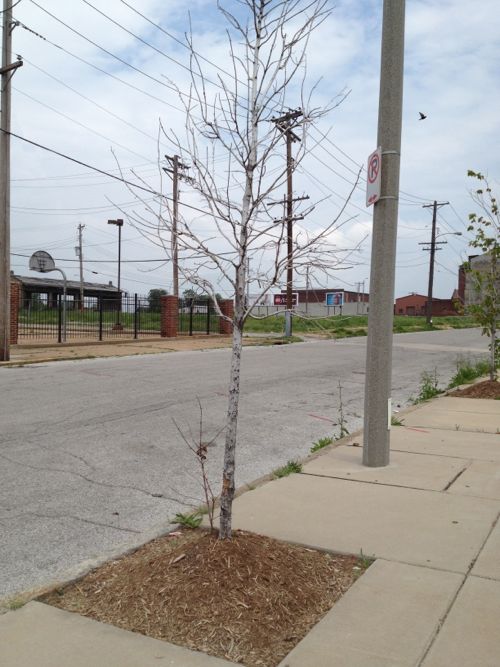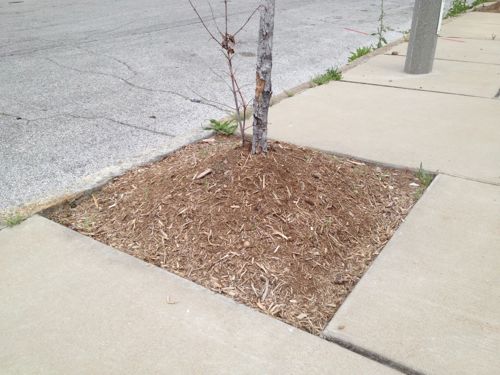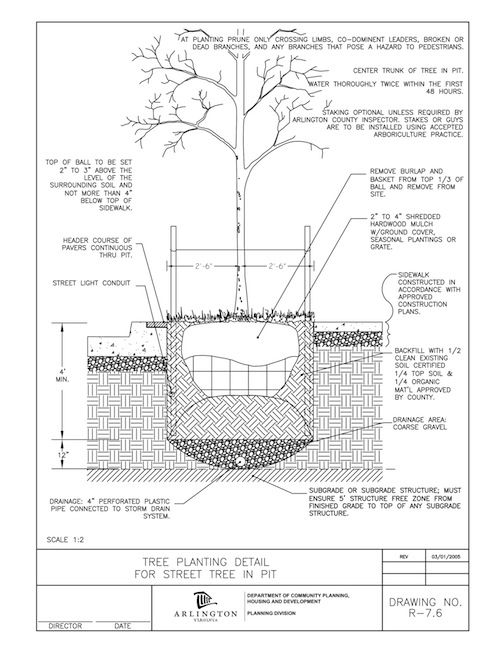Street Trees Must Be Planted Deep Enough the Root Ball Won’t Dry Out
The Crown Food Mart at 1515 N. 13th opened in 2009, with street trees planted on all sides. Few have survived.

Some will say the city is a harsh environment for street trees, the road salt and chemicals used to clear snow & ice from streets is too much for new trees to handle. Perhaps, but when half the root ball is above the level of the adjacent sidewalk the tree is going to dry out and die. If it happens to survive it will eventually bust the sidewalk as shallow roots seek water.

How should it be planted? Deeper!

I don’t know if a contractor for the new building or the city planted these trees, whomever it was did a poor job.
— Steve Patterson
The other half of the equation is water – hot and dry will kill almost anything, and surrounding any tree with concrete makes for a harsher micro environment. You just can’t plant it, you have to water it!
That’s why it’s so important to place the ball so it can benefit from runoff feom the sidewalk.
Wider tree wells would also help significantly. 5×5 does not allow much space for roots to spread out, which is why most street trees look like little lollipops.
Unfortunately, any void larger than 5′ x 5′ takes up too much of the sidewalk. I’ve experimented with using narrower and longer tree wells just to create more soil space. But the presence of the lighting conduit remains the real obstacle.
Your section shows optimal planting conditions: plenty of room for drainage and organic enrichments. Unfortunately, existing conditions will not always allow a contractor or owner to plant a tree per your section. 1) Aggregates are left behind after a new sidewalk is poured, and contractors don’t remove those aggregates in the tree well before the tree is planted. No one notices after the mulch is placed. Usually, “more important” items exist on the punch list, and the trees are unfortunately given little notice. 2) More often than not, street lighting conduits and other utilities are buried in the pathway parallel and adjacent and within close proximity to the curb. The presence of these utilities prevents the contractor from providing a hole deep enough to accommodate the root ball. Once a tree well has been formed out of a new sidewalk, you do everything possible to “fit” the tree to the well and hope for the best. Often, you just can’t achieve the “best”. 3)I have seen many trees survive (not flourish) even when the root ball is only partially covered. But the adjacency of the newly planted tree to the street creates a hostile environment for anything living. Salt, buses scraping the tree canopy, and high temps reached on the surface of the asphalt all contribute to the problem.
Everyone loves landscaping! So do I when it’s maintained. But often, building owners plant it (to satisfy local building ordinances), then forget it. Nothing looks worse than poorly-maintained landscaping. Much of the existing parking-lot landscaping now required by City ordinance looks like crap. And in my opinion, it does more to detract from the neighborhood ambiance than the actual parking lot itself.
We look at a street tree planted off-centered with exposed root ball in a sidewalk and immediately we might blame the landscaper. But I’ve never worked with a landscaper who would rather take short cuts and plant a shallow or off-centered tree vs. doing it right the first time. TYPICALLY, HE HAS TO GUARANTEE THAT TREE FOR A YEAR. How do you comfortably guarantee a tree that is shoved up against aggregate on one side and whose root ball is partially exposed? And it takes longer to try to “finagle” a tree into place than it would take to properly place it (centered and at full depth). If you look at the photographs in your post, you’ll notice the tree is planted almost at the edge of the void. Next to the tree is a utility pole. I would bet my last buck that the conduits feeding that pole run 18″ below sidewalk grade and are located dead center in the sidewalk void. Relocating the conduit is costly, and most owners are not willing or able to afford it.
The biggest crime I find is after the planting. Matter of fact, the tree placement agreement spells out the requirements for placing trees in the right of ways with regards to utilities, hole size, yada, yada.
BUT after planting, no land owner can expect the city to water every tree. It just isn’t physically possible. Land owners have to step up to the plate, especially when they don’t want to do it: the hottest days of the year.
Then there is the mulching. Every responsible landscaper and the forestry workers I’ve met know that one NEVER mounds mulch around the base of trees. This causes shallow root growth that will show up years later in cracked walkways and worse, topple overs. Mulching needs to be circular and away from the trunk of the tree.
It’d be better not to plant such a big tree at all if the hole can’t be dug deeply enough for the root ball; though planting *too deep* is not good, either. And don’t get me started about volcano-style mulching (2′ up the trunk at St Mary’s Hospital on Clayton Ave in Richmond Heights!) or trenching around trees to make a nice neat border with the grass (cutting many, many tree roots, Wash U!).